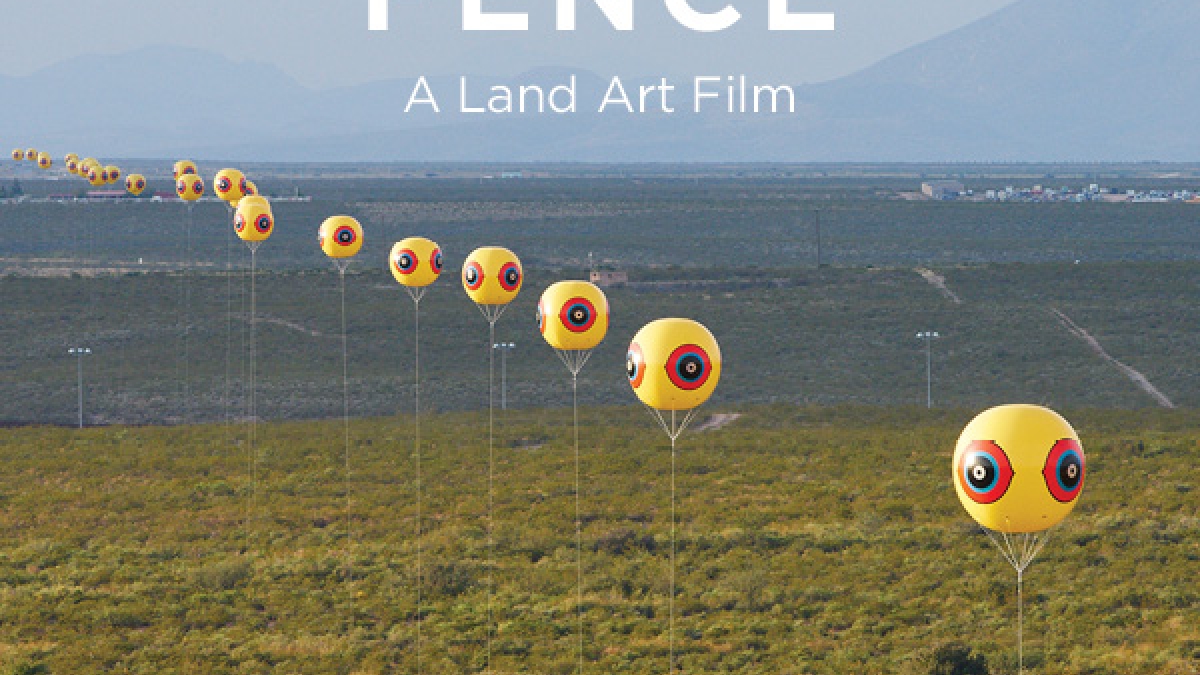Documentary featuring 2 ASU alums to premiere at MoMA festival

“Through the Repellent Fence: A Land Art Film,” from director Sam Wainwright Douglas, will have its world premiere at The Museum of Modern Art’s 16th annual Documentary Fortnight film festival, in New York, Feb.16–26.
“Through the Repellent Fence” follows Postcommodity, a transdisciplinary arts collective comprised of artists Raven Chacon (Navajo), Cristóbal Martínez (Mestizo/Xicano) and Kade L. Twist (Cherokee), as they “put land art in a tribal context” and bring together a community to construct Repellent Fence, a two-mile long ephemeral monument “stitching” together the United States and Mexico. Both Martínez and Twist are alumni of Arizona State University’s Herberger Institute for Design and the Arts.
Martínez received a doctorate in rhetoric, composition and linguistics from the Department of English in ASU’s College of Liberal Arts and Sciences in 2015. Prior to that, he earned a master's in media arts and science and bachelor’s degrees in studio art and in painting, from the Herberger Institute’s School of Arts, Media and Engineering and School of Art, respectively. He is currently a postdoctoral fellow in indigenous art, digital design and education in ASU’s Mary Lou Fulton Teachers College and in the Herberger Institute. Twist received his MFA in intermedia from the Herberger Institute School of Art in 2012.
In 2015, aided by the communities on both sides of the border and with support from the ASU Art Museum, the artists installed a series of 26 huge inflatable spheres emblazoned with an insignia known as the “open eye,” which has existed in Indigenous cultures from South America to Canada for thousands of years. The spheres were evenly spaced apart and extended north and south of the border a mile in each direction, “a metaphorical suture stitching together cultures that have inhabited these lands long before borders were drawn.”
The film provides an intimate glimpse into the arduous process behind creating an ambitious artwork giving voice to the shared history and enduring culture of Indigenous societies that have made the region their home for thousands of years before a border ever divided it. In this challenging political climate, where the debate over a “wall” between Mexico and the United States has been the hot topic of the last year, “Through the Repellent Fence” is remarkably prescient.
Intercut with this thread are lush scenes, using stunning cinematography, of striking land art environments that have preceded Postcommodity’s work. The film is set to a haunting original score by Alex Maas of The Black Angels.
“Through the Repellent Fence” is an adventure in the artistic process blended with a road trip of discovery, visiting sites and diverse perspectives to explore how land art can generate community interaction and perceptual shifts in how we interpret, engage and draw inspiration from our natural world. Scenes with other artists and intellectuals working in the land art realm provide context and insight as well. These include Chris Taylor of Texas Tech University’s Land Arts of the American West program, writer Lucy Lippard and Matt Coolidge of the Center for Land Use Interpretation.
“I wanted to make this film to dispel the misconceptions about the U.S.- Mexico border and to add nuance to the narrative,” said Douglas. “Life in the borderlands is so much more complex and richer than the mainstream media and most of our politicians seem to understand. This is a border story that has not been told: Indigenous artists giving voice to the shared history of Indigenous people who have traveled back and forth for thousands of years, reminding the world that being Indigenous does not stop at a border. And the art they created is beautiful, participatory and brings people together. It's an art project at its finest: invigorating the public, finding common ground and reinforcing the bond between people and place.”
Douglas is a director and editor working in Austin, Texas, who most recently directed and edited “Honky Tonk Heaven,” which premiered and won an audience award at South by Southwest 2016. He also edited and co-produced “No No: A Dockumentary,” which premiered at the 2014 Sundance Film Festival, and edited and produced the PBS documentary “Ladonna Harris: Indian 101,” which was executive produced by Johnny Depp and broadcast on PBS in 2014. Douglas also directed “Citizen Architect: Samuel Mockbee and the Spirit of the Rural Studio," which was broadcast nationwide on PBS in 2010.
“Through the Repellent Fence: A Land Art Film“ was produced by Jeffrey Brown (“No No: A Dockumentary”); David Hartstein (“Where Soldiers Come From”); and Julianna Brannum, (“Ladonna Harris: Indian 101”).
Postcommodity has been selected for the 2017 Whitney Biennial.
Screenings at MoMA’s Doc Fortnight 2017:
4:30 p.m. Saturday, Feb. 18 — T1, Theater 1
Post-screening discussion with filmmakers and Postcommodity
2:30 p.m. Sunday, Feb. 19 — T1, Theater 1
Ticket information: moma.org/calendar/events/2824